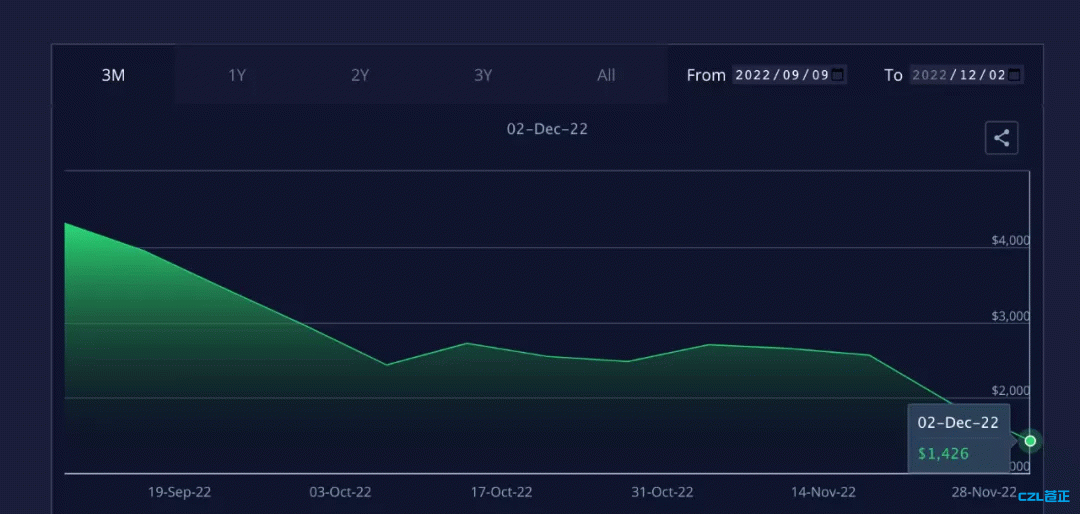Some freight forwarding companies even quoted a freight rate of USD 1,000/FEU for the Asia-Europe route.
As 2023 approaches, the downward trend in spot freight rates in the container shipping market continues.
The World Containerized Freight Index (WCI) released by Drewry last week showed that the spot freight rate on the Asia-Europe route fell by 10% to US$1,965/FEU in a week, and the figure has fallen by 50% in four weeks.

Some analysts said that if freight rates on the Asia-Europe route continue to fall at this rate, spot freight rates will fall below US$1,500/FEU around Christmas.
Although freight rates on the Asia-Europe route have fallen sharply, there are still freight forwarders offering lower prices.
According to media reports, a freight forwarding company recently quoted a freight rate of US$1,000/FEU for the Asia-Europe route, covering the route from major Chinese ports to the UK's Felixstowe Port, Southampton Port and London Port.
Regarding the current market situation, Lars Jensen, CEO of Danish shipping consultancy Vespucci Maritime, believes that the liner market is experiencing a "hard landing."
He believes that the Chinese New Year on January 22, 2023, is "the only light at the end of the tunnel."
Lars Jensen explained: “The market is currently trending in such a way that spot freight rates will bottom out after the Chinese New Year.”
He further stated that if the global economic recession trend is mild and inventory adjustments are the main influencing factor of the demand plunge, then freight volumes in the summer of 2023 may surge, causing spot freight rates to soar again.
However, if the recession becomes deeper and longer, freight demand will be suppressed in 2023, with a surge in freight volumes only expected before the Chinese New Year in 2024.
He believes that no matter which situation, once the freight rate plummets, it will lead to operational chaos in the container shipping market, because liner companies will continue to suspend voyages on a large scale, suppressing the further decline of spot freight rates.
Maersk recently stated in its latest Asia-Pacific market information report that the current market spot freight rate plunge is "dramatic" and the company "is adjusting its network to adapt to the new market reality."
In addition, the decline in freight rates on the Asia-Europe route also reflects the decrease in freight demand on the Asia-Europe route.
Generally speaking, carriers will make every effort to maximize the cargo capacity of a ship on its maiden voyage. However, just a few days ago, the "Ever Atop" ship with a container capacity of 24,004 TEUs started its maiden voyage to Northern Europe, but the loaded containers were less than three-quarters.
In this regard, some analysts believe that the underutilization of the Ever Atop and other ships encountering similar situations further proves the serious shrinkage of transportation demand in Northern Europe.
A few days ago, the head of a European liner company said: "Because the current cargo volume in the market is not enough to support the operation of the route, we have suspended more than one-third of our ships."
The person in charge further stated: "We need to survive the Christmas holidays first." At the same time, he hopes that the sluggish current situation in the container shipping market will improve before the Chinese New Year.
It is also understood that on the Asia-Europe route, the ships currently in operation have suffered serious navigation losses. Due to the lack of profits from operations, liner companies are facing huge operating cost pressures.
At the same time, spot freight rates on trans-Pacific routes have continued to fall.
According to the Global Container Freight Index (FBX) jointly released by the Baltic Exchange and Freightos, on December 2, the freight rate on the US-West Coast route was US$1,426/FEU, a sharp drop of 26.3% compared with US$1,935/FEU on November 25.
However, some analysts believe that after U.S. consumers' online spending reached a record high of $9.12 billion during this year's Black Friday, retail inventories need to be replenished, and new orders may boost cargo volumes on trans-Pacific routes to prevent spot freight rates from falling.
Maersk also said that despite the bleak outlook, there were "signs of activity" in some U.S. retail sectors.
In contrast, the freight rate on the transatlantic route remains "firm". The freight rate on December 2 was US$6,358/FEU, down 2.6% from US$6,527/FEU on November 25, a smaller drop.
This has also made the transatlantic route a new favorite in the market, and liner giants have continuously increased their capacity deployment on this route.
The Ocean Alliance recently announced that it will further increase the capacity of the transatlantic route by replacing the four 8,500TEU to 10,000TEU ships on the route with four 11,000TEU to 14,000TEU ships.
Original source:https://mp.weixin.qq.com/s/EC15mO22Iv1s1RKRQsrhjw